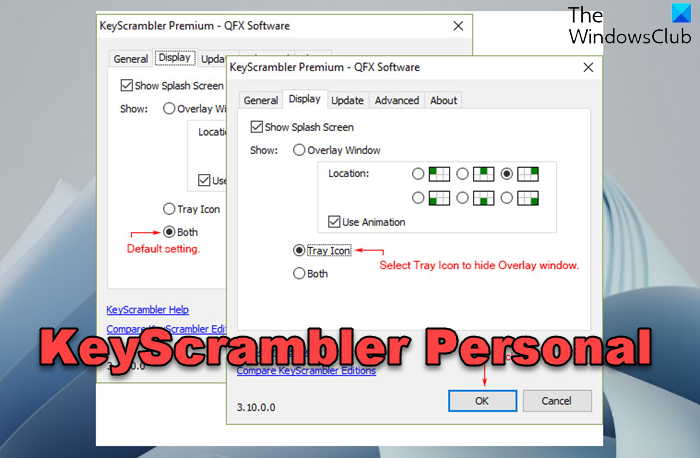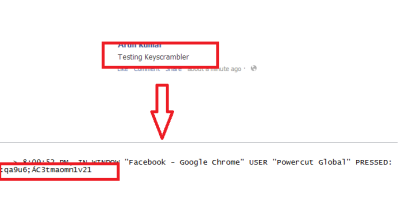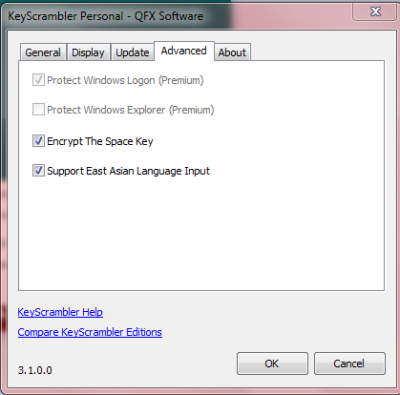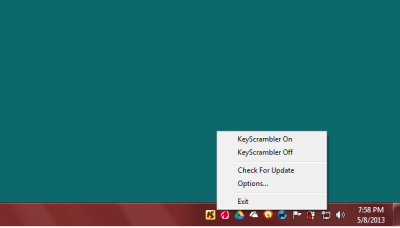In this online age where most of your work is done online, you need proper protection from snoopers, etc. Some people and bots collect information about you and use it for their benefit. We have been covering different methods to stay safe on the Internet. This review of KeyScrambler Personal Free, an anti-keylogging software that encrypts keystrokes in a browser, is part of the series to keep your information private when you are surfing and entering your information using browsers.

Do note that, in this review, we are covering only the free version of KeyScrambler – and that is KeyScrambler Personal.
KeyScrambler Personal: Works Between Keyboard and Cache
Nothing can provide you with complete safety, and you may have to compensate for the security with speed or something else – including money! The best Internet security product is The Onion Router (TOR). But it is pretty slow, so you may not wish to use it for regular usage. The product we are reviewing in this post is software that changes the keystrokes into something else and is entirely different from TOR or its likes. While TOR is a browser based on a maze of routers to make you untraceable, KeyScrambler is something that acts between your keyboard and keyloggers. This means it changes – or rather – encrypts the characters you type into something else before it gets to any other part of the computer.
KeyScrambler is a Windows OS tool that encrypts keystrokes to protect users from keyloggers. It safeguards your inputs by converting them into gibberish. KeyScrambler can easily be activated or deactivated when you restart your device. Safeguard your data with this user-friendly software.
To see how it works, I installed a keylogger on my computer. The following image shows what I typed in Facebook and what was logged by the keylogger. This review proves KeyScramber works and is one of the best keyboard encryption software available for free. I say it is among the best because, in the keylogger report, no one can make sense of what was typed in the browser!
An unknown keylogger on your computer can be the worst thing to happen. Keyloggers can give away all the information you type, and most of them also track the URLs of websites you visit. That means if you visit your bank account, the person who installed keyloggers on your computer can easily read and replicate your bank password plus ID. The same danger also applies to private and important documents, etc.
Keystroke encryption ensures that every keystroke you make on your Windows device is encrypted on the kernel level and sent securely to the targeted application. This encryption prevents other applications from capturing sensitive information. Once the encrypted keystrokes reach the intended window, they are decrypted for use.
Limitation of KeyScrambler Personal Free
While KeyScrambler helps you stay secure on the Internet when using a browser, it offers no protection when you are typing on – say, Microsoft Word or any email Client. In this case, the encryption of characters typed is limited to browsers. But since most of today’s work is browser-based, having KeyScrambler Personal on your machine secures you to a large extent.
If you use browser-based word processing software such as Office Web Apps, you are secure. If you are using browser-based email, you are protected – as KeyScrambler is compatible with almost all known browsers. The only problem is that it won’t scramble (encrypt) the data you type into computer-based software such as an email client or a word processor installed on your local computer.
I do not know why KeyScrambler chose to keep the local software out of encryption. The paid version does provide security when you are working on Windows Explorer, but my concern is Microsoft Word and similar applications.
A different system is probably at work when passing keystrokes to browsers than giving them to locally installed word processing documents, including email clients. Maybe it is possible to encrypt the encrypted keyboard cache before passing the keystrokes to browsers. I suppose the keystrokes are passed directly to programs for local installations before any other software can access and encrypt them. I do not know it for sure; please share it with me if you have any information on this.
KeyScrambler Personal Review: Best Browser KeyStroke Protection
Do not get tense if your KeyScrambler icon says you are not protected. I was almost irritated while trying to review KeyScrambler and seeing the tray icon off. The problem was that I was trying to use MS Word and Notepad. It wouldn’t turn on, even though the system tray menu showed it as turned on.
Only when I switched to my browser, I notice that it had turned on. So when you are working on anything other than your browser, the KeyScrambler is dormant. It is activated automatically as soon as you switch to browsers. You might even see a KeyScrambler Strip at the center of the browser as and when you open or switch to your browser – any browser.
MY VERDICT: This review of KeyScrambler highlights the following points:
- You are entirely secure when typing into (ANY) browser – be it Firefox, Chrome, Edge, Opera, or anything else! It even worked on the portable version of Mozilla.
- The protection is limited to browsers. For better security, you must install good anti-malware to detect and remove keyloggers. If you are using Windows Vista or above, you have the default Windows Defender that is good enough.
- Finally, it is not a tool to hide your IP address or encrypt all your Internet traffic. If you need such protection, use a VPN.
KeyScrambler Personal supports several browsers, and that is a huge plus point. You can download it from here. Works on Windows 11/10 too.
Do share your experiences, if any, with KeyScrambler Personal.
Also read: Free Keylogger software | Free anti-keylogger software
What is an encrypted keyboard?
Depending on if it’s a software or a hardware-enabled keyboard, any encrypted keyboard ensures that each character is not readable when it is passed from low level to high level. This ensures any keylogger trying to read the keypress cannot tap into the data.
What does monitoring keystrokes mean?
Every time a key is pressed a code is generated. A Keylogger, hardware or software, intercepts those keystrokes before sending it to the screen. It can then record and later make sense of it. So for example, if you type email and password one after the other, a hacker can look at the data and make sense of your password.



FYI, KeyScrambler is ineffective says this post https://hackyard.net/keyscrambler-is-ineffective.hy
If you have a good firewall, and it’s configured properly, and you didn’t accidentally give the key-logger permission to phone home through it, then said key-logger can collect all the keystrokes it wants…
…but the firewall should keep it from actually sending them anywhere. A good HIPS system should keep the key-logger from launching in the first place; and good anti-virus should detect it in any case. Even if it’s zero-day, at least SOMETHING should be noticed by the anti-virus software.if its heuristics are any good. Key-logging is, by definition, malware-like behavior. The anti-virus/anti-malware software would have to be abominably bad not to notice it, even if its signature is not yet in its malware database.
Anti-key-logger software is nice, but if one’s anti-virus/firewall software doesn’t either detect it, or block it if it doesn’t, then one needs new anti-virus/firewall software, not anti-key-logger software.
Gregg L. DesElms
Napa, California USA
gregg at greggdeselms dot com
I’ve got to say I agree with Mr. DesElms here; when I noticed Zemana free antilogger didn’t stop Kidlogger from recording Gmail usernames/passwords, I was told by Zemana techs that only the Pro (paid) version so protects from loggers licitly/illicitly on a PC, and does so by firewall-like alert offering block/allow option when detected; I find that Keyscrambler free is great where it works (it tells you if app is within its purpose or not) and DID frustrate Kidlogger insofar as Gmail usernames/passwords (anything online ONLY), but screenlogging, timestamping, etcetera were easily recorded by the logger. Like Mr. DesElms suggests, my own firewall installation and settings make it difficult for ANYTHING to “just become installed/operative”, and can identify/block ANY requests for internet transmission (even from kernel mode junkware)…about the only way to stop a logger known or unknown from being of use to a remote attacker.
Using KeyScrambler Personal Free + Zemana AntiLogger Free will defeat the purpose of Phrozen KeyLogger Lite, Kid Logger, HomeKey Logger, K9 Web Protection & numerous other Free or Paid KeyLoggers.
Zemana Antilogger Free & KeyScrambler Personal Free can co-exist on a system as KeyScrambler Personal uses Encryption Method: Blowfish (128-bit) and RSA (1024-bit). Outputs random characters. But, Zemana Antilogger Free uses Encryption Method: Blank output. Only the application with keyboard focus receives the keystrokes while others are blocked. So, its a Double layer of Protection, whenever KeyScrambler outputs Random Characters using Blowfish & RSA encryption keys, there is always a Blank Encryption or Clean Slate Wipeout of KeyStrokes happening using Zemana Antilogger Free, for Web Browsers. Zemana AntiLogger Free provides Blank Encryption of KeyStrokes for other Offline Softwares like MS Office, Notepad & numerous other Offline Softwares used for variety of Purposes.